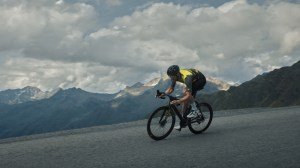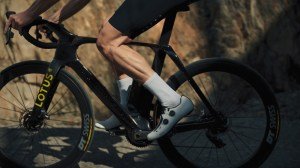[bsa_pro_ad_space id=14]
Another day, another new high-end bicycle from a British sports-car maker. First, Aston Martin revealed its new .1R road bike, then, just a day later, Lotus debuted the Type 136 e-bike. The two-wheel Lotus is powered in part by an electric motor developed for the Mars Lander. Priced at $25,000, the Type 136 First Edition will comprise 36 examples finished in Lotus’s black-and-gold Formula 1 livery (opening image).
So what’s going on? Is the shift to zero-emissions vehicles so profound that some of the most famous names in British motoring are giving up on cars altogether? Not quite. The weirdly close timing simply allowed both bikes to be shown at Rouleur, London’s high-end cycling show. Both marques know that their clients are increasingly turning to cycling rather than golf as they mature. Both marques have a history of making ground-breaking bicycles, and both of these bikes have been in development for years.

The Lotus Type 136 Standard Edition e-bike will be priced at $18,500.
Lotus’s cycling history is the longer and more illustrious. Every Lotus design since the firm was founded 75 years ago—from sports cars to Formula 1 cars—gets an official type number: the $2 million, 2,000 hp Evija EV hypercar is the Type 130, and the four-door Emeya hyper-GT (revealed in New York in September) is the Type 133. But one of the best-known and most-loved Lotus type numbers was applied to a bicycle: the radical Type 108 on which Chris Boardman won gold for Great Britain in the 1992 Barcelona Olympics; the country’s first gold medal in cycling for 72 years.
As controversial as it was successful, the 108 features a carbon-monocoque design that was later banned, and only eight examples were offered for sale to the public at an inflation-adjusted $40,000. Serious cyclists would kill to put one of these vanishingly rare bikes into their collections, which explains why Lotus is making a bicycle again, and why buyers won’t balk at the price of the Type 136, which drops to $18,500 after that first limited run.

Riding the Lotus Type 136 First Edition, which is presented in the black-and-gold Formula 1 livery made famous by the British automaker.
The Type 136 echoes the 108’s striking looks and carbon-monocoque design, and was overseen by Richard Hill, the same legendary aerodynamicist who worked on the Olympic bike and some of Lotus’s greatest sports cars. But while the track-only 108 has neither brakes nor gears, the road-going Type 136 has both, and adds a completely hidden electric-assistance system created by renowned ex-Formula 1 engineer Gary Anderson using a tiny, powerful, zero-maintenance e-motor. Did we mention it was developed for NASA’s Mars Lander?
The motor won’t power the Type 136 unaided, but the rider will be able to choose when to engage it and how much help it provides. It’s designed to allow you to conquer multiple alpine passes in a day rather than just one, or to keep pace with fitter and faster friends. It will run for around three hours, enough for a six- or seven-hour ride given that you won’t use it when descending, cruising, or with a tailwind. And if you run out of juice, the battery is disguised as a water bottle, and easily swapped.

The motor won’t power the Type 136 unaided, but the rider will be able to choose when to engage it and how much help it provides.
“I’ve been waiting since I was 16 to ride a Lotus bike, and despite the anticipation, it doesn’t disappoint,” says Sir Chris Hoy to Robb Report. A six-time Olympic gold medalist, an eleven-time world champion, and now a successful racing driver, Hoy helped launch the Type 136 at the Lotus store on London’s Piccadilly. “It’s hard to overestimate the impact the Type 108 had. I was on holiday with my family when Chris Boardman won gold on it at the Olympics and it made me jump on my rented mountain bike and ride myself to exhaustion for an hour. But by the time I started racing, the design had been banned.”

Sir Chris Hoy, six-time Olympic gold medalist and eleven-time world champion, helps debut the Lotus Type 136 in London.
Hoy also mentions that “the e-motor system is very light, so the 136 still handles like a proper high-performance bike. Yet it just gives you that little push in the back when you need it.”
But does one of the most successful—and powerful—cyclists ever to turn a pedal condone the use of artfully hidden electrical assistance? “It’s not about competing. You’re still using your legs and your lungs. You’re still working as hard, and you’ll come home just as tired, but you’ll have got more out of your ride. Would you rather climb one mountain pass in a day unaided, or two with this bike? It’s about getting more out of the experience.”
[bsa_pro_ad_space id=15]
